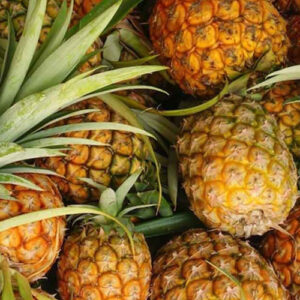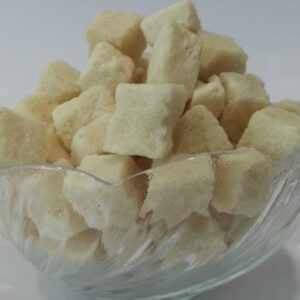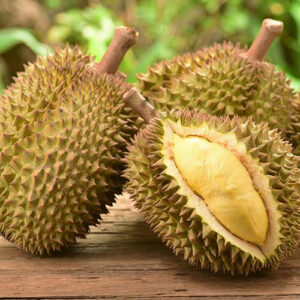Description
According to USDA 1 ounce (oz) or approximately 49 kernels of unroasted unsalted pistachios contain
NUTRIENTS IN 100 g OF DRIED UNBLANCHED BRAZIL NUTS
| Calories: 159 |
| Protein: 5.7 grams(g) |
| Fat: 12.8 g |
| Carbohydrates 7.7g |
| Fiber: 3.0g |
| Sugars: 2.2g |
| Magnesium 34.3 milligrams (mg) |
| Potasium 139 mg |
| Thianim 0.25 mg |
| Vitamin B6 0.5 mg |
Benefits From Eating Pistachios
- Loaded with nutrients
- High in antioxidants
- Low in calories yet high in protein
- May aid weight loss
- Promote healthy gut bacteria
- May lower cholesterol and blood pressure
- May promote blood vessel health
- May help lower blood sugar
- Delicious and fun to eat
About Pistachios
The pistachio tree is native to regions of Central Asia, including present-day Iran and Afghanistan.[4][5][6][7] Archaeology shows that pistachio seeds were a common food as early as 6750 BC.[8] The modern pistachio P. vera was first cultivated in Bronze Age Central Asia, where the earliest example is from Djarkutan, modern Uzbekistan.[9][10]
It appears in Dioscorides’ writings as πιστάκια : pistákia, recognizable as P. vera by its comparison to pine nuts.[11]
Pliny the Elder writes in his Natural History that pistacia, “well known among us”, was one of the trees unique to Syria, and that the seed was introduced into Italy by the Roman Proconsul in Syria, Lucius Vitellius the Elder (in o�ce in 35 AD) and into Hispania at the same time by Flaccus Pompeius.[12]
The early sixth-century manuscript De observatione ciborum (“On the observance of foods”) by Anthimus implies that pistacia remained well known in Europe in Late Antiquity.
An article on pistachio tree cultivation is brought down in Ibn al-‘Awwam’s 12th-century agricultural work, Book on Agriculture.[13]
Archaeologists have found evidence from excavations at Jarmo in northeastern Iraq for the consumption of Atlantic pistachio.[8]
The Hanging Gardens of Babylon were said to have contained pistachio trees during the reign of King Merodach-Baladan about 700 BC.[8]
Pistachio trees were introduced from Asia to Europe in the 1st century AD by the Romans. They are cultivated across southern Europe and north Africa.[14]
In the 19th century, the pistachio was cultivated commercially in parts of the English-speaking world, such as Australia along with New Mexico[15] and California where it was introduced in 1854 as a garden tree.[16]
In 1904 and 1905, David Fairchild of the United States Department of Agriculture introduced hardier cultivars to California collected from China, but it was not promoted as a commercial crop until 1929.[15][17] Walter T. Swingle’s pistachios from Syria had already fruited well at Niles, California, by 1917.[18]
Botany
Leaves of a pistachio tree in Syria.
Habitat
Pistachio is a desert plant and is highly tolerant of saline soil. It has been reported to grow well when irrigated with water having 3,000–4,000 ppm of soluble salts.[15] Pistachio trees are fairly hardy in the right conditions and can survive temperatures ranging between −10 °C (14 °F) in winter and 48 °C (118 °F) in summer. They need a sunny position and well-drained soil. Pistachio trees do poorly in conditions of high humidity and are susceptible to root rot in winter if they get too much water and the soil is not su�ciently free-draining. Long, hot summers are required for proper ripening of the fruit.
Dormant Kerman Variety pistachios growing in California
Dormant Kerman pistachio trees in California.
Characteristics
The tree grows up to 10 m (33 ft) tall. It has deciduous pinnate leaves 10–20 centimeters (4–8 inches) long. The plants are dioecious, with separate male and female trees. The �owers are apetalous and unisexual and borne in panicles.
Pistachio
Pistachio fruit, Torbat-e Heydarieh, Razavi Khorasan, Iran
Pistachio
Pistachio tree, cultivar: Napoletana
The fruit is a drupe, containing an elongated seed, which is the edible portion. The seed, commonly thought of as a nut, is a culinary nut, not a botanical nut. The fruit has a hard, cream-colored exterior shell. The seed has a mauve-colored skin and light green �esh, with a distinctive �avor. When the fruit ripens, the shell changes from green to an autumnal yellow/red and abruptly splits partly open. This is known as dehiscence, and happens with an audible pop. The splitting open is a trait that has been selected by humans.[19] Commercial cultivars vary in how consistently they split open.
Each pistachio tree averages around 50 kilograms (110 lb) of seeds, or around 50,000, every two years.[20]
The shell of the pistachio is naturally a beige color, but it is sometimes dyed red or green in commercial pistachios. Originally, dye was applied by importers to hide stains on the shells caused when the seeds were picked by hand.[21] Most pistachios are now picked by machine and the shells remain unstained, making dyeing unnecessary except to meet ingrained consumer expectations.
Cultivation
Pistachio nuts from Iran
The pistachio tree is long-lived, possibly up to 300 years.[22] The trees are planted in orchards, and take approximately seven to ten years to reach significant production. Production is alternate-bearing or biennial-bearing, meaning the harvest is heavier in alternate years. Peak production is reached around 20 years. Trees are usually pruned to size to make the harvest easier. One male tree produces enough pollen for eight to twelve drupe-bearing females. Harvesting in the United States and in Greece is often accomplished using equipment to shake the drupes o� the tree. After hulling and drying, pistachios are sorted according to open-mouth and closed-mouth shells, then roasted or processed by special machines to produce pistachio kernels.
In California, almost all female pistachio trees are the Kerman cultivar, from Kerman, Iran. A scion from a mature female ‘Kerman’ is grafted onto a one-year-old rootstock.
Diseases and environment
See also: List of pistachio diseases
Pistachio trees are vulnerable to numerous diseases and infection by insects such as Leptoglossus clypealis.[23] Among these is infection by the fungus Botryosphaeria, which causes panicle and shoot blight (symptoms include death of the �owers and young shoots), and can damage entire pistachio orchards.[24] In 2004, the rapidly growing pistachio industry in California was threatened by panicle and shoot blight first discovered in 1984.[25] In 2011, anthracnose fungus caused a sudden 50% loss in the Australian pistachio harvest.[26] Several years of severe drought in Iran around 2008 to 2015 caused significant declines in production.[27]
Production
Pistachio production, 2019
Country Production
(tonnes)
Iran 337,815
United States 335,660
China 106,155
Turkey 85,000
Syria 31,813
World 911,829
Source: FAOSTAT of the United Nations[28]
In 2019, global production of pistachios was about 0.9 million tonnes, with Iran and the United States as leading producers, together accounting for 74% of the total (table). Secondary producers were China, Turkey, and Syria.[28]
A 2020 report indicated that nearly half of the global production of pistachios in 2019 came from the United States, with production in Iran falling to as low as 7% due to US trade sanctions against Iran, climate change, and weak economic and water management in Iran.[29][30] E�orts to grow pistachios for international markets were made during 2019 in Georgia and adjacent Caucasus countries.
Pistachio Detail
IN SHELL PISTACHIOS – NATURALLY OPENED PISTACHIOS:

In-Shell: Almost 90% of California pistachios are consumed as in-shell snacks. Most of these in-shell varieties are roasted and salted or seasoned in the shell.
Grading:
- US FANCY
- US EXTRA NO.1
- US NO.1
- US SELECT

| NUT SIZE |
AVERAGE NUMBER OF NUT PER OUNCE |
| SIZE DESIGNATION |
|
| Colossal |
Less than 18 |
| Extra Large |
18 to 20 |
| Large |
21 to 25 |
| Medium |
26 to 30 |
| Small |
More than 30 |
The size of these nuts is generally calculated by the number of nuts as per ounce. For example, one ounce of pistachios will contain 18 to 40 nuts. This varies according to different cultivars. Availability of particular sizes varies year to year.
Shelled:
Shelled pistachios are used in flavoring for various food products including confectionery, ice creams and bakery goods.

Grading:
- US FANCY
- US EXTRA NO.1
- US NO.1
- US SELECT
- Size: 80% Whole, 60% Whole and halves and small pieces.
|
Non-Split & Non Split on Suture |
Adhering Hull Material |
Light Stained |
Dark Stained |
Others Damages |
Undersized |
| US Fancy |
2% |
1% |
5% |
2% |
1% |
5% |
| US Extra No.1 |
3% |
1% |
9% |
3% |
1% |
5% |
| US No.1 |
6% |
1% |
22% |
3% |
2% |
5% |
| US Select |
10% |
2% |
N/A |
3% |
3% |
5% |
| US Artificially opned |
10% |
2% |
N/A |
3% |
10% |
4% |
| US Non-Split |
N/A |
2% |
N/A |
3% |
N/A |
5% |
External defects

Internal defects
|
Damage |
Series Damage* (Vertebrate Injury, Mold & Rancid) |
Insect Damage (Already in *) |
Total Internal Defects |
| US Fancy |
3% |
2% |
1% |
4% |
| US Extra No.1 |
6% |
2% |
2% |
8% |
| US No.1 |
6% |
2% |
2% |
9% |
| US Select |
6% |
2% |
2% |
9% |
| US Artificially opned |
6% |
2% |
2% |
9% |
| US Non-Split |
6% |
2% |
2% |
9% |
Other defects
|
Shell* |
Blanks (Already included in*) |
Foreign Material (No metal , glass or live insects present) |
Particles & Dust |
Loose Kernel |
| US Fancy |
2% |
1% |
0.25% |
0.25% |
4% |
| US Extra No.1 |
2% |
1% |
0.25% |
0.25% |
5% |
| US No.1 |
2% |
1% |
0.25% |
0.25% |
6% |
| US Select |
2% |
1% |
0.25% |
0.25% |
6% |
| US Artificially opned |
2% |
1% |
0.25% |
0.25% |
6% |
| US Non-Split |
2% |
1% |
0.25% |
0.25% |
6% |

METRIC CONVERSION TABLES
Use the following table for metric conversion
| INCHES |
MILLIMETERS |
| 5/64 |
1.98 |
| 18/1000 |
0.46 |
| 1/4 |
6.35 |
| 30/64 |
11.88 |
| OUNCES |
GRAMS |
| 1 |
28.35 |
| 2 |
56.7 |
















Reviews
There are no reviews yet.